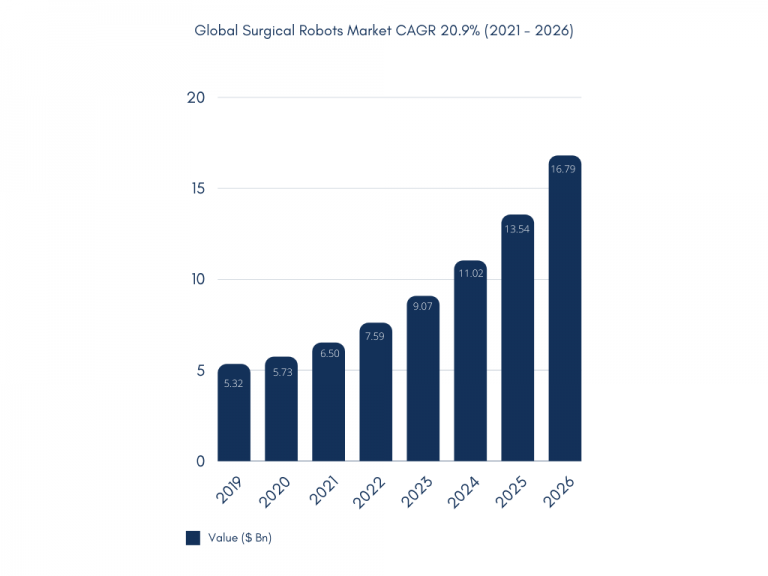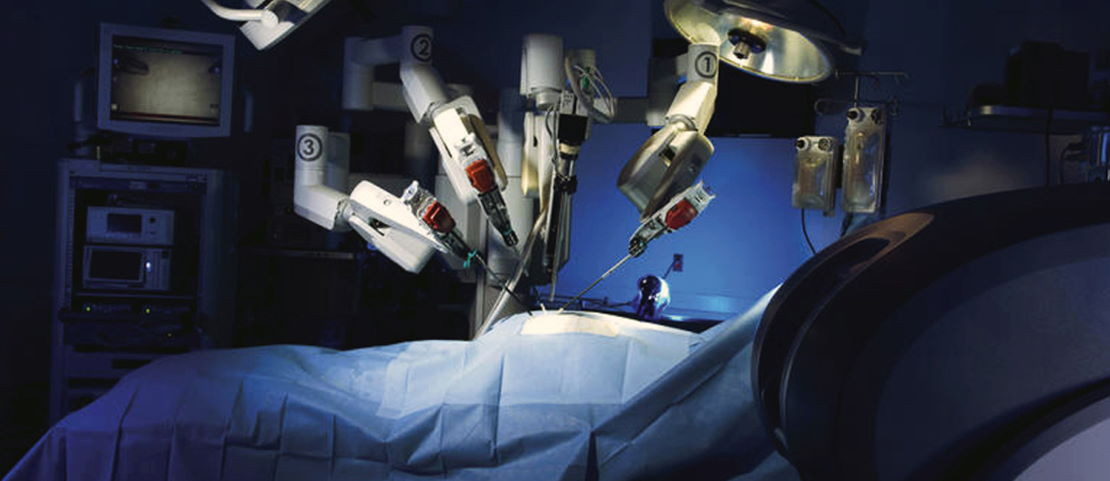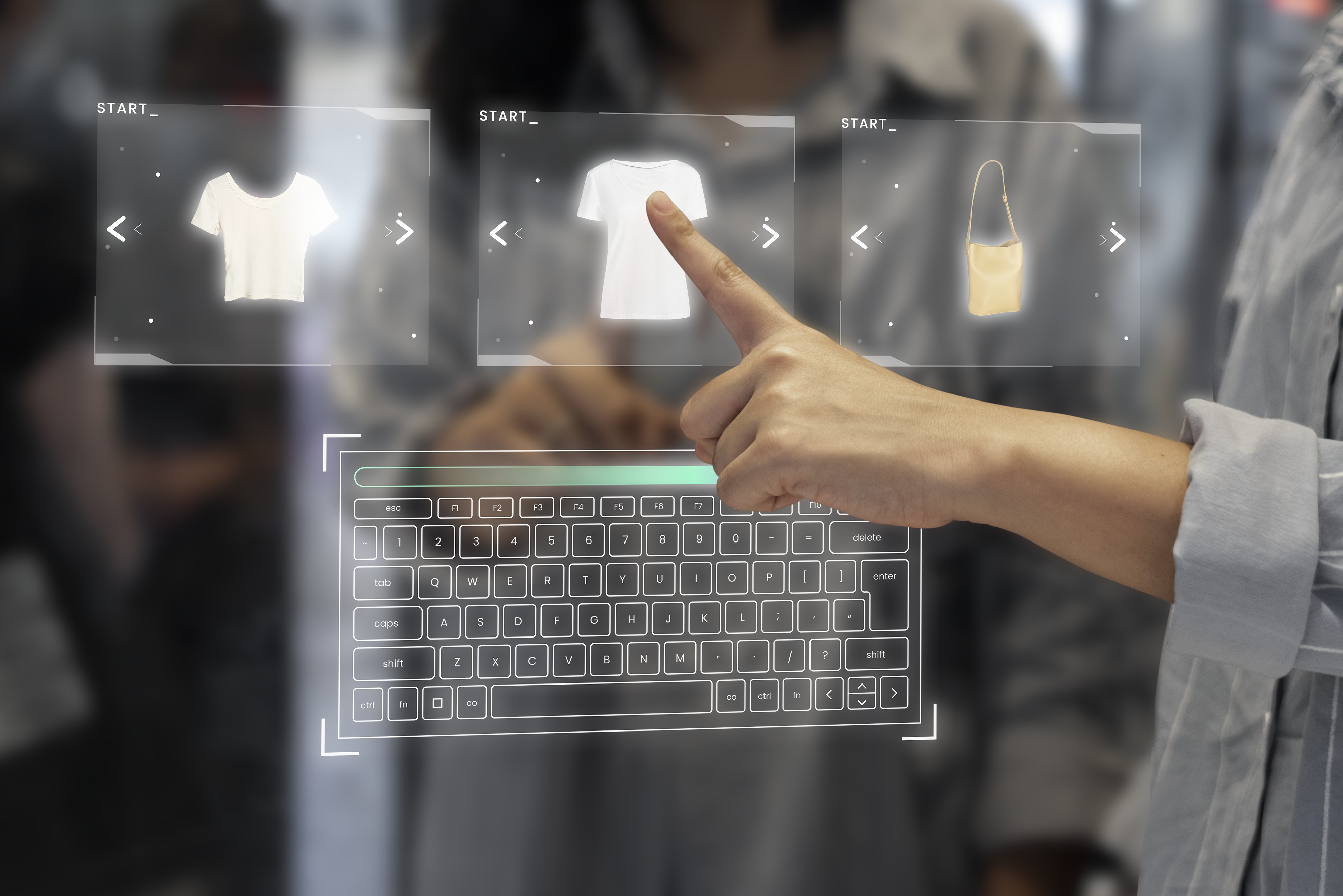Overview
Technological advancements tend to alleviate human capacity beyond imagination. Surgical Robotics is one such shining example of it. Robots have been used for medical purposes since the 1980s when the US military first developed prototypes for remotely controlled robots to treat soldiers. Since then, the concept of these robots for surgical purposes has been developed, and these robots are also evolving as we usher into a new era of technological advancements.
With the outbreak of COVID-19, great barriers were created that separated doctors from patients physically. The increasing adoption of the 5G network boosted the concept of robotic or telesurgeries and the market for surgical robots. Moreover, the advancements in autonomous and intelligent solutions are making these tools increasingly helpful to surgeons, completing complex tasks autonomously so that surgeons only need to focus on important decisions. They are also making the surgeries with the minimum invasion possible. Today, surgical robots created by the Da Vinci systems are the key leader in the market. Its robotic systems have performed more than 10 million agencies worldwide1.
The Global Surgical Robots market was valued at around US$ 6.5 Billion in 2021 and is expected to grow to US$ 16.6 Billion, at a CAGR of more than 20% during the forecast period.


Key Benefits of Surgical Robots:
- The robots offer the surgeons the benefits of smaller incisions, better control, precision, and better access to areas hard to reach with human hands.
- Increasing the adoption of autonomous surgical robots will reduce the training time of surgeons for complex procedures.
- The expertise of surgeons can be available in remote areas where they cannot access that surgeon physically. E.g. Corindus’s research in India demonstrated the world’s first percutaneous coronary intervention (PCI) remotely outside the lab2.
- Even for patients, surgical robots ensure minimum incisions and faster recovery. Hence, the hospitalisation time is reduced.
“We move the arms of the robots while sitting comfortably. I have one surgeon who told me it will extend his career by a decade.” 3
– Dr Gerard M. Doherty, surgeon-in-chief at Brigham and Women’s Hospital in Boston
With these benefits, certain risks also come related to higher costs, complications arising from machine failures, and more time consumed in some surgeries. However, these risks do not come in the way of adopting surgical robots, as their benefits outweigh the risks. Future generations are likelier to choose surgeries aided and performed by robots in all medical fields. That brings us to examine various applications of surgical robots.
Applications of Surgical Robots
The concept of telesurgery is not that new. Its first demonstration was performed in 2001 when a surgeon in New York operated on a 68-year-old woman in France. However, remote surgeries gained prominence post-pandemic because of the circumstances they created. In March 2019, a doctor in China used remote surgery tools to implant a stimulation device into a patient’s brain with a case of Parkinson’s situated 1900 miles away. Today, robots are used in surgeries in many medical fields, such as neurology and gynaecology. Below is an account of various fields in which these robots are helping surgeons.
- Neurosurgery – This field will particularly benefit from nanotechnology innovations as they offer precision and control for reconnection of nerves and other sensitive procedures.
- Tumour Resection Surgeries – In Oncology, detecting and mapping tumours in surgery can be improved.
- Spine surgery – The robots can offer good intraoperative support by steadily holding instruments and implant components on the target during screw placement for the decompression procedure.
- Prostate Surgeries – There will be smaller incisions with surgical robots, and they will also ensure that the blood vessels or nerves are not damaged. It means faster recovery for the patients.
- Peritoneal cavity surgery – Especially with the help of a miniature robot, these surgeries are becoming more efficient and faster.
- Gynaecology – With more precision and control, surgical robots can make gynecologic surgeries less painful for women and minimise the damage to the uterus procedures like hysterectomy.
“The system provides fully-fledged real-time connectivity of the surgeon and the area under surgery in terms of visual, auditory, tactile, and haptic means. Because of this, the application of robotic surgery is not just limited to joints and abdomen, but also to help procedures of heart, brain, spine, and almost everywhere.” 4
– Jayakrishnan T, Founder and CEO, Asimov Robotics
Besides these, surgical robots are increasingly finding their prominent applications in cardiovascular and thoracic surgeries.
Futuristic Technological Innovations in Surgical Robots
Surgical robots constantly evolve to become more precise, efficient, and widely applicable. Efforts are being made by plenty of market players to make their products different from others in terms of alternative design, form factor, approach to surgery or new integrated technology. This section explores how surgical robots are becoming technologically advanced for more wide futuristic applications and companies (or start-ups) making it possible.
Autonomous Robots:
There are two kinds of surgical robots: first, robots that play assistive roles to the surgeons during the surgeries, and second, robots that operate surgery autonomously with surgeons controlling them remotely. Developments in sensor technologies and complementing technologies such as AI make it more autonomous to navigate inside the body and perform functions, allowing surgeons to focus on more important things during the surgery. This improves medical efficiency, safety, and reliability. Below are some of the advancements in this direction:
- STAR (Smart Tissue Autonomous Robot) – This surgical robot developed by the Children’s National Health System in DC performed a laparoscopic operation on a pig’s soft tissue without the Guidance of a surgeon’s hands. With advanced technologies such as NVIDIA’s GPU and 3D imaging systems, it adjusts its surgical plan in real-time.
- Titan Medical’s SPORT (Single Port Robot) – This system achieves automation in positioning cameras by tracking the surgeon’s gaze or the position of their instruments.
- ZAP Surgical Systems – This USA-based company is developing a radio-surgical robot for the non-invasive ablation of brain and neck tumours.
Improved vision and Guidance:
Surgical robotics is increasingly integrating with AR/VR and 3D cameras to offer surgeons more accurate and real-time visualisation of the surgery to guide and assist them in performing more accurate procedures. Such augmented reality shows structures to the surgeons that they otherwise could only have known by touch. This visualised Guidance reduces the surgeon’s cognitive load and improves efficiency.
- Vicarious Surgical – This healthcare robotics start-up combines miniature robots with VR to put the surgeon inside the patient’s body.
- Mazor – This platform, acquired by Medtronic, uses 3D cameras to map surgical sites for optimal robotic arm movement.
- THINK Surgical, USA – It creates 3D preoperative planning for knee and hip replacement surgeries.
- Comofi Medtech – A Bengaluru-based healthcare robotics start-up, created a guide to help visualise the target area in great detail.
Increased Precision:
Certain medical procedures require utmost precision and agility, such as heart surgeries. Surgical robots offer greater freedom of movement and precision of action. Surgical robotics is making Minimal Invasive Surgeries (MIS) possible and taking the help of technologies like GPS and satellite navigation to improve the accuracy of the procedure while operating remotely.
- Single Port Model – Intuitive launched an improved surgical robotic system in 2018. It allows surgeries to be carried out through a single incision.
- Super microsurgery – MANTA, a design company, is currently conducting a human trial of surgery on 0.3-0.8 mm vessels. This will allow the robots to repair microvasculature with great precision.
- Microsure – This Dutch start-up is developing a robot for precision in microsurgery that can connect vessels as small as 0.3 mm.
- Innovative Design – Its robot ‘SIRA (Saline-assisted Intraoperative Radio Ablation Device), uses bipolar current to create a controlled ablation zone. Its CEO Tyler Wanke opines that this device is the new option for intraoperative ablation of soft tissue. By allowing maximum contact with the target tissue, the devices are used in radiation therapy post-lumpectomy to reduce the time involved significantly.
Sensor Technology and Haptics:
The surgical robots are slowly equipped with advanced high-precision sensors to reflect force, pressure, torque, and other parameters that the surgeon can only feel by touch. Companies are also working on enabling surgical robots with Haptic sensing, using advanced sensors to help the surgeons see and feel the body’s tissue from a separate location,
- The STAR robot uses touch and vision sensors to locate valve leaks in the heart. It makes gentle tapping contact with the heart wall to gauge the precise location.
- Mako Surgical, acquired by Stryker, provides robots that give precise feedback to surgeons for repairing arthritic knee joints.
- Strong Cambridge Research and Development is developing a new haptic device that surgeons can wear anywhere on the body. It uses linear actuation to mimic the sense of touch.
Surgical robots enabled with these tactile and haptic sensations are certainly the future of this field for more accurate and guided MIS.
Ergonomics:
While making the surgical robots more efficient and advanced, the companies are also developing ways to make them ergonomically usable to the surgeons to give them a good user experience. This is particularly important to make a case for making surgical robotics more desirable over traditional methods.
Corindus Corepath GPX system designs their robots so that the control module is located remote to the radiation path, removing the necessity to wear heavy lead aprons for the surgeons.
The Road Ahead
With the technologies like 5G, AI/ML, AR/VR, and 3D imaging, the world of surgical robotics is rapidly advancing, making them more applicable and efficient. Moreover, surgeons are becoming familiar with the RAS and its benefits, contributing to the demand for these surgical robots. It comes with its challenges, such as the physical strain and lack of tactile feedback to the surgeons operating, the high cost of adoption (The average initial cost of robotic setup is about $2 million5), and complications due to machine or failure. However, researchers are diligently working to overcome these barriers and make surgical robots a common reality of the future. The field is still developing, and even investors are interested in this opportunity. VC firms and investment companies like Sequoia, SOSV, True Capital, HAX, Kleiner Perkins, and many more are funding start-ups and showing interest in this opportunity. In 2022, a Swiss med-tech company, Distalmotion, raised $90 million in Series E funding led by Revival Healthcare Capital to commercialise its surgical robot, Dexter6. Reflecting such promises, remote surgeries fully performed by autonomous robots seem like a not-so-distant future.






